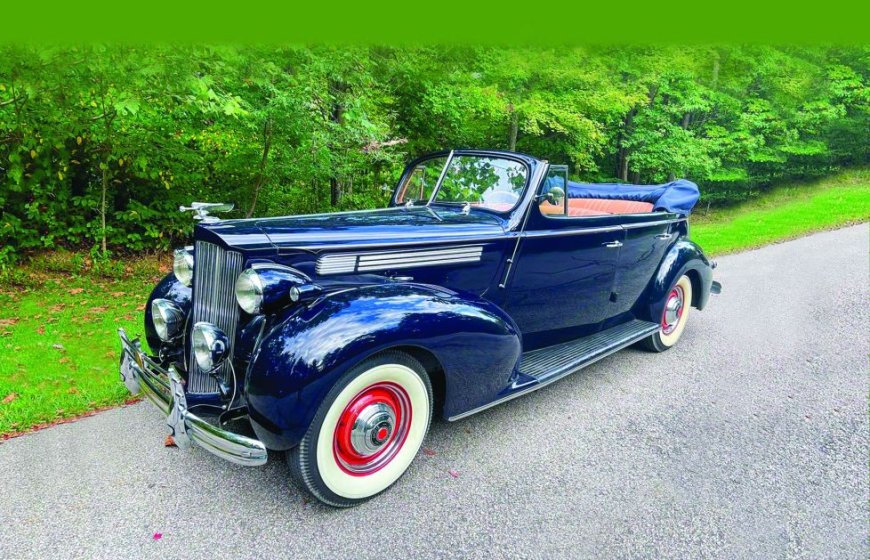The Packard 120 Lives Up To Its Original Promise As The Affordable Luxury Eight-Cylinder
The Packard 120 (or One-Twenty) was an important car, but it doesn’t get a lot of ink these days. But then, ink isn’t all the rage anymore either… except, maybe, at tattoo parlors. Times change and the legions of young people getting inked aren’t sitting around reading out-of-print books or old Special-Interest Autos articles about… The post The Packard 120 Lives Up To Its Original Promise As The Affordable Luxury Eight-Cylinder appeared first on The Online Automotive Marketplace.

The Packard 120 (or One-Twenty) was an important car, but it doesn’t get a lot of ink these days. But then, ink isn’t all the rage anymore either… except, maybe, at tattoo parlors.
Times change and the legions of young people getting inked aren’t sitting around reading out-of-print books or old Special-Interest Autos articles about Packards, yearning to understand how one of America’s greatest automakers went extinct.
But if they did, they’d learn that the junior-series 120 helped save Packard from fading into oblivion prior to WWII, right alongside Peerless and Pierce-Arrow. Those are two other great American automakers that many heavily tattooed young people haven’t heard of. Today, the 120 is still true to its original mission as a finely made, easy driving, relatively affordable, eight-cylinder luxury car. They can be attractively priced and enthusiasts who own these elegant mid-level Packards love them for many good reasons.
The 120 upholds the Packard reputation for nearly silent, vibration-free engines; precise shifting transmissions; light steering; balanced handling for the era, thanks to its innovative Safe-T-Flex independent coil-spring front suspension; and powerful (again, for the time) hydraulic brakes. The 120 series was split into two generations: 1935-1937 and 1939-’42—in 1938, the 120 was named the Packard 8 or Packard Eight. There were seven body styles in ’35: three coupes, three sedans and a convertible (Convertible Coupe, actually). For ’36 there was a Convertible Sedan added; in ’37 a station wagon (or Station Sedan) with a wood body was offered, and was joined later in the year by a longer-wheelbase Limousine and Touring Sedan. When the 120 returned in ’39, there were nine body styles, including the Limousine and in ’40 the Darrin-bodied Victoria Convertible joined the mix. The second generation also brought “Handishift” column shifting, available overdrive, all-synchromesh three speed gearboxes, and headlights integrated into the fenders for 1941.

Suffice it to say throughout the run there was a style and powertrain combo to suit every aspiring Packard 120 owner. The same is true today and pricing lines up about as you’d expect: sedans are priced lowest, coupes command more while convertibles and wagons bring the most. How much? We’ve seen some nice sedans trading for $20,000 and under, and some nice coupes in the $30,000 range. If you’re eyeing a convertible or wagon, you’d better budget a minimum of $50,000 and then expect to spend more. Wagons can fetch north, sometimes far north, of $100,000 and Convertible Coupes and Sedans can range from $70,000 to $90,000. A Victoria could soar into the high six figures.
The aggregator classic.com estimates that first generation 120s (all body styles included, and private sales excluded) have sold for an average of $42,557 over the last five years. The lowest sale was $3,850 for a rough 1937 120 sedan while the highest sale was a 1936 Convertible Coupe that changed hands for $90,200.
The average sale price for all second-generation 120s over the last five years was $52,292. The lowest recorded sale was for a rough 1940 coupe that changed hands for $5,500. The highest sale was for a station wagon that sold at a Pebble Beach auction in 2022 for $268,800. The 1939 120 Convertible Sedan featured here was listed on Hemmings.com as of this writing with an asking price of $89,000.
The overall price trend for all 120s has been mostly flat for the past five years. Even during and after the pandemic, when many vintage vehicles spiked in value, Packard 120s remained steady. While this may not bode well for speculators, it does make these cars attractive to aspiring Packard owners—as they’ve always been.
We don’t see Packard 120 popularity or average values exploding over the coming years any more than we’d expect a sudden resurgence in paper and ink publishing but, for obvious reasons, we stay enthusiastic about both.

The post The Packard 120 Lives Up To Its Original Promise As The Affordable Luxury Eight-Cylinder appeared first on The Online Automotive Marketplace.











































